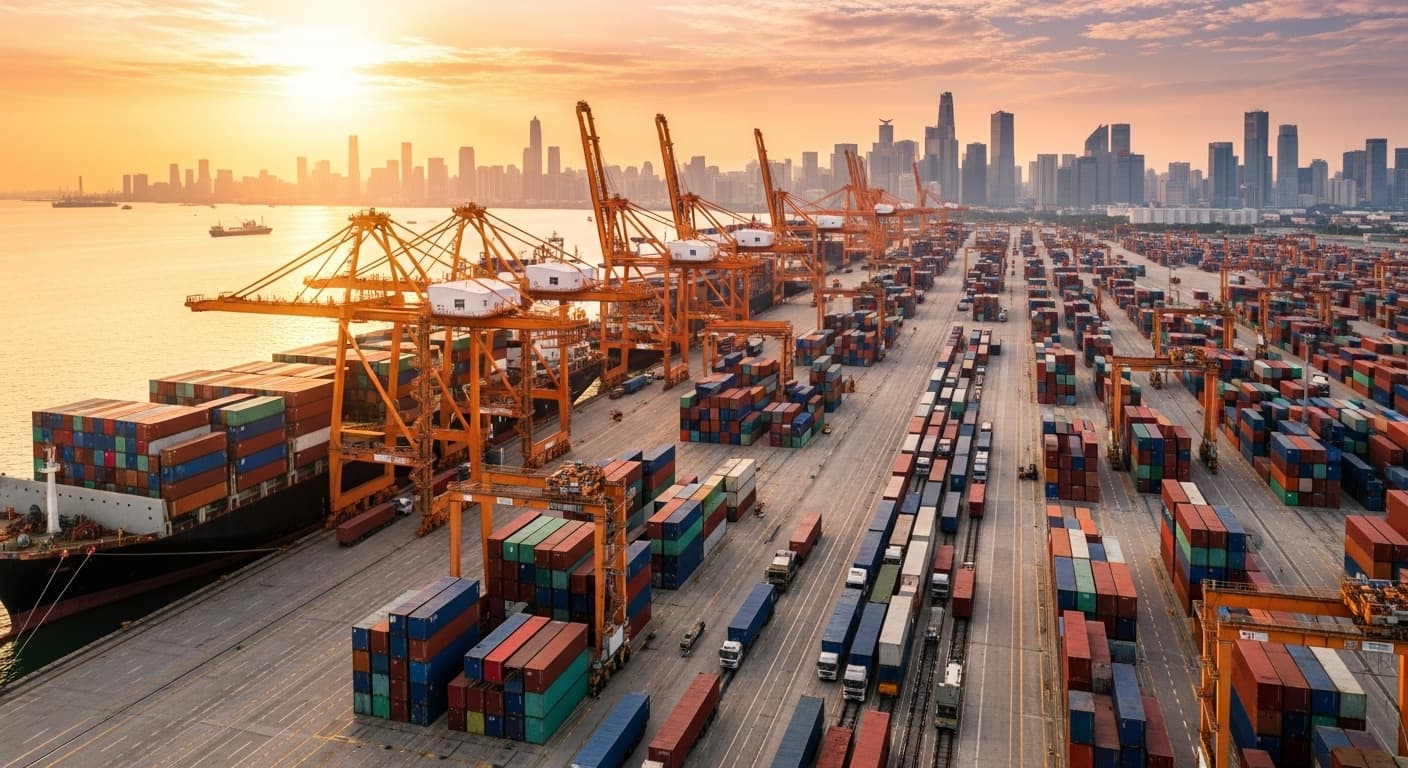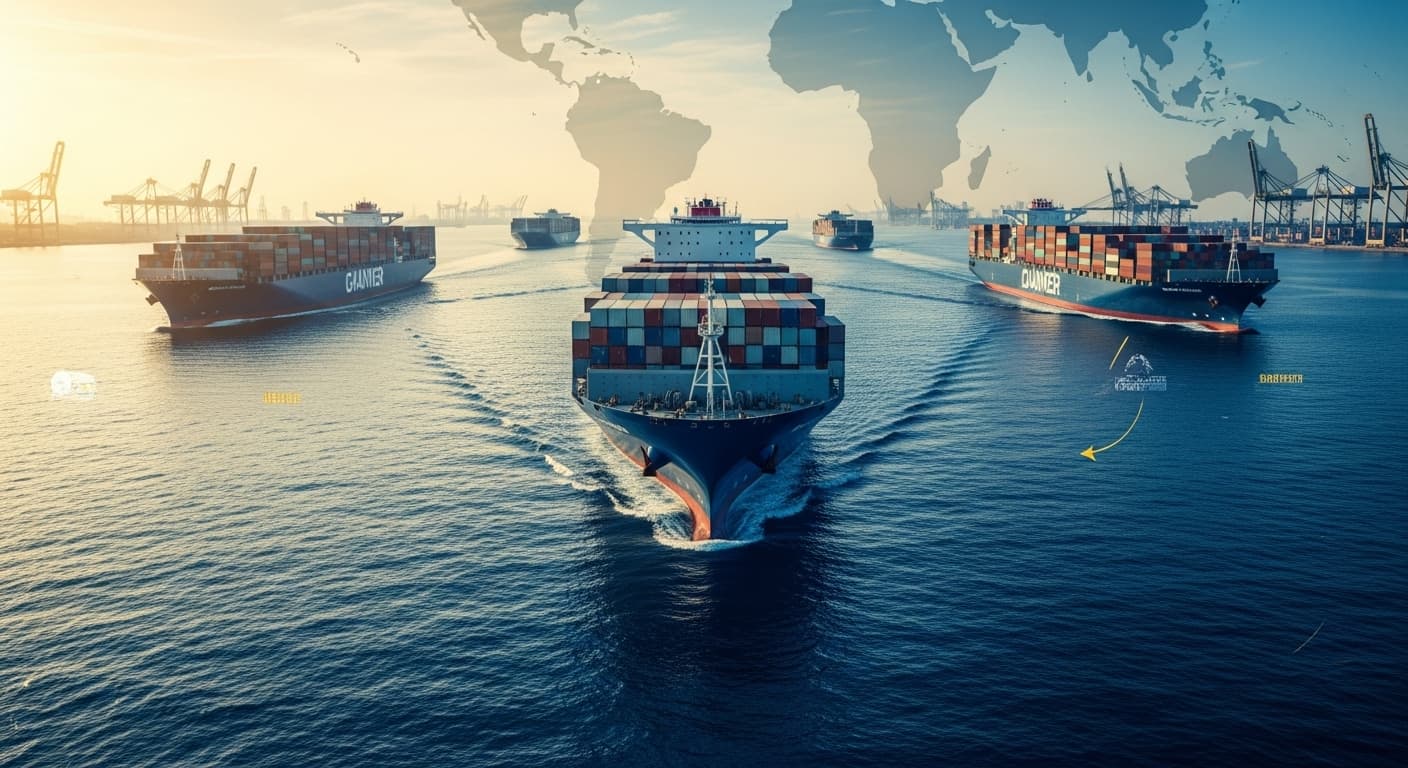
Executive Summary
Transatlantic ocean freight routes between Europe and the United States are experiencing significant rate volatility in 2025, driven by carrier capacity management strategies, shifting trade patterns, and evolving regulatory requirements. Understanding the dynamics affecting Europe-US freight rates—including blank sailings, alliance restructuring, and external market pressures—enables shippers to develop effective strategies for navigating this uncertain environment and managing transportation costs across the Atlantic.
Transatlantic Freight Dynamics: Understanding Rate Volatility on Europe-US Routes
(跨大西洋货运动态:了解欧美航线运价波动)
1 · Market Context and Current Conditions
The transatlantic container shipping market connecting Europe and the United States serves as critical trade corridor supporting billions of dollars in annual commerce. Understanding current market dynamics provides essential context for rate movements and strategic decision-making.
Transatlantic Trade Significance
Trade Volume and Characteristics: The Europe-US shipping corridor handles substantial containerized cargo flows in both directions, though the trade remains somewhat imbalanced with varying cargo characteristics:
Eastbound Flows (US to Europe): Exports from the United States to Europe include agricultural products and processed foods, machinery and industrial equipment, chemicals and pharmaceutical products, and various consumer goods. These shipments tend to be more seasonal and commodity-focused compared to westbound flows.
Westbound Flows (Europe to US): European exports to the United States feature manufactured goods and automotive products, machinery and industrial components, pharmaceutical and chemical products, and premium consumer goods. These flows demonstrate different demand patterns and pricing dynamics than eastbound movements.
Market Size Context: While Asia-Europe and Trans-Pacific routes handle larger absolute volumes, the transatlantic trade lane represents important market for carriers and crucial supply chain link for companies operating in both regions. The route’s characteristics differ from larger trade lanes in ways that affect pricing and capacity dynamics.
2025 Rate Environment
Volatility Patterns: Transatlantic freight rates have experienced significant fluctuations throughout 2025, though the pattern differs from dramatic swings seen on Asia-Europe routes:
Rate Movement Characteristics: After experiencing rate declines in early 2025 reflecting softer demand and increased capacity, the market has seen periodic rate recovery attempts through carrier capacity management. However, these increases have proven difficult to sustain given underlying demand conditions and competitive pressures.
Comparative Dynamics: While Asia-Europe routes witnessed dramatic rate collapses with FBX11 (Freightos Baltic Index for Asia-Europe) falling 32.67% in a single month, transatlantic routes have shown more moderate movements. This difference reflects distinct supply-demand dynamics, different competitive structures, and varying responses to market conditions.
Current Rate Levels: Industry projections place average transatlantic freight rates around $1,550 per TEU for 2025, though actual rates vary significantly based on specific lanes, container types, service contracts versus spot market, and timing within the year. Individual shipment rates may differ substantially from this average depending on specific circumstances.
2 · Carrier Strategies and Capacity Management
Ocean carriers serving transatlantic routes employ various strategies to manage capacity and influence rate levels in response to market conditions that don’t always support their pricing objectives.
Blank Sailings as Primary Tool
Understanding Blank Sailings: Blank sailings—the practice of canceling scheduled vessel voyages—represent carriers’ primary mechanism for adjusting available capacity to match demand levels. This practice affects market dynamics in several ways:
Capacity Impact: By removing vessel sailings from schedules, carriers reduce total available container slots in the market. This artificial capacity tightening can support rate increases even when underlying demand doesn’t naturally create capacity constraints.
Implementation Patterns: Carriers typically announce blank sailings several weeks in advance, citing various operational or commercial reasons. The frequency and scale of blank sailings indicate carriers’ assessment of supply-demand balance and their willingness to sacrifice volume to maintain rates.
Market Effects: Blank sailings create tighter container availability for shippers during affected periods, potentially forcing some cargo onto premium services or alternative routings. However, if underlying demand remains soft, capacity tightness may prove temporary as carriers need volume to cover fixed costs.
Alliance Restructuring Impact
New Alliance Formations: Major carrier alliances serving transatlantic routes underwent significant restructuring in 2025, affecting service patterns and competitive dynamics:
Gemini Corporation: The formation of the Gemini Corporation partnership between Maersk and Hapag-Lloyd created substantial capacity under coordinated management on transatlantic routes. This concentration of market share in single alliance affects pricing power and service configuration.
Premier Alliance: The Premier Alliance combining Ocean Network Express (ONE), HMM, and Yang Ming provides alternative capacity grouping serving transatlantic markets. The alliance structure affects how these carriers coordinate capacity and pricing decisions.
THE Alliance: The existing THE Alliance continues serving transatlantic routes, creating three-way competitive dynamic among major alliance groups. This structure affects how capacity adjustments and pricing strategies play out in the market.
Operational Adjustments: Alliance restructuring involves network redesign, service consolidation, and operational integration that can create temporary disruptions or inefficiencies. These adjustments affect service reliability and capacity availability during transition periods.
General Rate Increase Attempts
GRI Implementation Patterns: Carriers periodically announce General Rate Increases (GRIs) attempting to raise baseline rate levels across transatlantic routes:
Announcement Examples: Maersk announced freight rate increases to $2,600 per TEU for 20-foot containers and $4,000 per FEU for 40-foot containers on European routes. Hapag-Lloyd implemented comprehensive rate increases covering multiple container types and equipment categories. Other carriers announced similar increases with varying timing and amounts.
Implementation Challenges: Successfully implementing and sustaining GRIs depends on market conditions supporting rate increases. When demand remains soft or capacity exceeds requirements, competitive pressures often erode announced increases, with actual rates settling below announced levels.
Market Resistance: Shippers resist rate increases when market conditions don’t justify them, negotiating exceptions, seeking alternative carriers, or shifting cargo timing. This resistance limits carriers’ ability to implement increases unless underlying market tightness supports them.
3 · Economic and Trade Factors
Broader economic conditions and trade patterns significantly influence transatlantic freight demand and rate dynamics.
European Economic Context
Growth and Inflation: Europe’s economic performance in 2025 affects import demand and overall trade activity:
Modest Growth: European economies have experienced modest GDP growth, limiting expansion of import demand compared to periods of stronger economic performance. This moderate growth constrains cargo volume growth on westbound routes.
Inflation Dynamics: Relatively high inflation in European economies affects consumer purchasing power and business investment decisions, creating uncertainty about demand patterns. Central bank monetary policy responses to inflation influence economic activity and trade flows.
Industrial Production: European industrial output and manufacturing activity directly affect cargo flows as finished goods move to US markets and raw materials or components flow in reverse direction. Industrial production trends provide leading indicators for freight demand.
US Economic Factors
Consumer Demand: US consumer spending patterns significantly influence European exports to America, as substantial portion of westbound cargo serves consumer markets. Economic confidence, employment levels, and disposable income all affect import demand.
Dollar Strength: Exchange rate movements between dollar and euro affect relative prices of imports and exports, influencing trade volumes. Dollar strength makes European goods more expensive for US buyers, potentially dampening import demand.
Industrial Requirements: US manufacturing and industrial activity generates demand for European machinery, components, and materials. Industrial production trends and capital investment patterns affect cargo volumes on transatlantic routes.
Trade Policy Considerations
Tariff Uncertainty: While the Trump administration’s tariff policies primarily target Asian imports, broader trade policy uncertainty affects business planning and supply chain decisions that can indirectly impact transatlantic flows:
Trade Diversion Effects: Policies affecting one trade lane can create ripple effects as companies adjust sourcing patterns, manufacturing locations, and distribution strategies. These adjustments may increase or decrease specific transatlantic cargo flows depending on how companies respond.
Investment Decisions: Trade policy uncertainty influences where companies invest in production capacity and how they structure supply chains. These longer-term decisions affect future trade patterns and freight demand on various routes including transatlantic lanes.
4 · Cost Pressures and Regulatory Factors
Various cost factors and regulatory requirements influence carrier operating expenses and ultimately affect freight rates charged to shippers.
Fuel Cost Dynamics
Bunker Fuel Prices: Marine fuel costs represent substantial portion of carrier operating expenses, typically comprising up to 50% of total costs:
Price Trends: Very Low Sulfur Fuel Oil (VLSFO) prices have increased from approximately $700 per metric ton in 2024 to projected $730 in 2025. While this represents moderate increase compared to historical volatility, even small percentage changes translate to significant absolute cost impacts given fuel’s large share of total expenses.
Rate Transmission: Carriers pass fuel cost changes to shippers through Bunker Adjustment Factors (BAF) or similar surcharges. Industry estimates suggest that fuel cost increases of this magnitude translate to approximately 4.3% higher freight rates, all else equal.
Volatility Management: Fuel price volatility complicates both carrier cost management and shipper budgeting. Various mechanisms including fixed bunker surcharges, formulaic adjustments tied to published fuel indices, and all-in pricing approaches attempt to manage this volatility.
Environmental Regulatory Compliance
EU Emissions Trading System: The inclusion of shipping in the EU Emissions Trading System (EU-ETS) creates additional compliance costs for vessels calling European ports:
Cost Structure: Carriers must purchase emission allowances for CO2 emissions, with costs depending on carbon prices and total emissions. These costs particularly affect routes serving European ports, including transatlantic services.
Surcharge Implementation: Many carriers implement specific EU-ETS surcharges to recover compliance costs, appearing as separate line items on freight invoices. These surcharges vary based on routing, voyage characteristics, and carbon price fluctuations.
Competitive Implications: Asymmetric regulatory costs between regions create competitive considerations affecting routing decisions, port selection, and overall network design.
IMO Carbon Intensity Regulations: International Maritime Organization (IMO) Carbon Intensity Indicator (CII) regulations progressively tighten requirements for vessel operational efficiency:
Compliance Approaches: Carriers employ various strategies to meet CII requirements including vessel speed reductions (slow steaming), hull and propeller maintenance and optimization, route optimization and weather routing, and in some cases vessel modifications or early retirements.
Service Implications: Some compliance approaches, particularly slow steaming, affect transit times and service schedules. These operational changes can influence service competitiveness and shipper preferences.
5 · Supply Chain Restructuring Trends
Broader supply chain reconfiguration trends influence cargo patterns and demand on transatlantic routes.
Regionalization and Nearshoring
Supply Chain Geography: Companies increasingly focus on regional supply chains and nearshoring production closer to end markets:
Motivations: Multiple factors drive these trends including risk mitigation after supply chain disruptions, desire for shorter lead times and greater responsiveness, transportation cost management, and regulatory or political considerations encouraging local production.
Transatlantic Implications: These trends create complex effects on transatlantic freight, potentially reducing some long-distance Asia-Europe or Asia-US flows that might otherwise transit transatlantic routes, increasing intra-regional production and distribution within Europe or North America, and potentially increasing certain component or material flows between Europe and US as production networks adjust.
Manufacturing Location Decisions
Production Geography: Companies’ decisions about where to locate manufacturing affect cargo flows on various routes:
Eastern European Production: Some companies have established or expanded production in Eastern Europe, serving both European markets and potentially exporting to United States. This affects transatlantic cargo patterns depending on final market destinations.
Mexican Manufacturing: Production in Mexico primarily serves North American markets but may affect European companies’ decisions about serving US markets, potentially reducing transatlantic flows of finished goods while potentially increasing component or material shipments.
6 · Strategic Considerations for Shippers
Shippers managing transatlantic cargo movements should consider various strategies to navigate rate volatility and manage costs effectively.
Transportation Mode and Route Optimization
Multimodal Opportunities: Combining ocean transport with inland rail or truck services can optimize total landed costs:
Inland Routing: Strategic selection of origin and destination ports combined with efficient inland transportation can reduce total costs. Industry estimates suggest multimodal solutions can reduce inland freight costs by up to 25% compared to alternative approaches.
Port Pair Selection: Different port combinations offer varying service characteristics and costs. Exploring alternative ports may uncover efficiency or cost advantages, particularly when traditional routes face congestion or premium pricing.
Service Level Trade-offs: Different services offer varying combinations of transit time, reliability, and cost. Matching service selection to cargo characteristics and requirements optimizes value rather than defaulting to fastest or cheapest option.
Contract Strategy Development
Spot versus Contract Balance: Mixing spot market purchases with longer-term contracts provides flexibility while managing cost volatility:
Contract Benefits: Long-term contracts provide rate predictability supporting budget planning, capacity assurance during tight markets, stronger carrier relationships and potential service priority, and protection from spot market spikes.
Spot Market Advantages: Spot market purchases offer flexibility to optimize timing and routing, ability to capitalize on rate dips, no minimum volume commitments, and access to multiple carriers without exclusive relationships.
Balanced Approach: Many shippers maintain majority of volume under contracts while retaining spot market flexibility for marginal volumes, seasonal peaks, or opportunistic rate capture.
Volume and Negotiation Strategies
Consolidation Opportunities: Aggregating shipment volumes strengthens negotiation position with carriers:
Internal Consolidation: Companies shipping through multiple divisions or locations can aggregate volumes for consolidated contracting, improving rates and service commitments through larger total volume.
Collaborative Approaches: Some shippers explore collaboration with other companies to aggregate volumes, though antitrust considerations and practical coordination challenges must be addressed.
Multi-Year Commitments: Some beneficial cargo owners are securing 2026 contracts at rates substantially below current spot prices, suggesting carriers offer meaningful discounts for longer-term volume commitments. These approaches lock in rates but reduce flexibility to capitalize on potential spot market improvements.
7 · Technology and Visibility Solutions
Modern technology platforms provide capabilities for managing transatlantic shipments more effectively.
Rate Management Tools
Market Intelligence: Various platforms provide visibility into current rate levels and trends:
Freight Indices: Published freight indices including Freightos Baltic Index (FBX) variants provide transparent market indicators, though transatlantic routes receive less index coverage than major Asia routes.
Rate Benchmarking: Platforms aggregating rate data from multiple sources enable shippers to benchmark their rates against market levels, supporting negotiation and decision-making.
Forecasting Tools: Predictive analytics and forecasting tools attempt to project future rate movements based on various market indicators, though accuracy limitations exist given market complexity.
Shipment Visibility
Tracking Capabilities: Modern visibility platforms provide real-time shipment tracking across ocean and inland segments:
Container Tracking: GPS-enabled containers and integration with carrier systems provide location visibility throughout transit, enabling proactive exception management and improved planning.
Documentation Flow: Electronic documentation platforms streamline bill of lading, customs paperwork, and related processes, reducing administrative burden and accelerating clearance.
Predictive ETAs: Advanced platforms provide predictive estimated time of arrival calculations considering vessel schedules, port congestion, weather, and other factors affecting actual arrival times.
8 · Risk Management Approaches
Managing risks associated with transatlantic shipping requires considering various potential disruptions and mitigation strategies.
Rate Volatility Risk
Financial Exposure: Rate volatility creates budget uncertainty and potential cost overruns:
Hedging Mechanisms: While freight derivatives markets exist for major routes, transatlantic hedging products have limited liquidity. Some financial instruments or contract structures can provide partial hedging.
Contract Structures: Contract terms including escalation clauses, rate adjustment mechanisms, and volume flexibility provisions help manage rate risk while maintaining necessary flexibility.
Service Reliability Risk
Disruption Sources: Various factors can disrupt transatlantic services including weather events affecting ocean crossings, port congestion or labor issues, carrier operational problems, and blank sailings or schedule changes.
Mitigation Strategies: Building appropriate transit time buffers into planning, maintaining relationships with multiple carriers, monitoring service performance and adjusting strategies, and developing contingency plans for critical shipments all help manage reliability risk.
Regulatory Compliance Risk
Changing Requirements: Evolving regulations create compliance requirements and potential disruptions:
Customs Procedures: US and European customs requirements must be strictly observed, with any documentation errors potentially causing delays and additional costs.
Trade Compliance: Sanctions, export controls, and other trade regulations require careful attention to avoid violations that could result in substantial penalties and operational disruptions.
9 · Future Outlook and Market Evolution
Understanding potential future developments helps inform longer-term strategic planning.
Short-Term Projections
Continued Volatility: Industry analysts expect transatlantic rate volatility to persist through 2025 and potentially beyond:
Capacity-Demand Balance: Carrier capacity management through blank sailings will likely continue as primary tool for influencing rates, creating periodic tightness followed by softer conditions as volume realities assert themselves.
Economic Sensitivity: Rate movements will remain sensitive to economic conditions in both Europe and United States, with any strengthening or weakening of demand quickly reflected in market conditions.
Structural Changes
Industry Evolution: Several longer-term trends may reshape transatlantic freight markets:
Consolidation Effects: Alliance restructuring and potential further industry consolidation could affect competitive dynamics and pricing power on transatlantic routes.
Technology Integration: Continued digitalization of freight booking, documentation, and tracking processes may improve efficiency and transparency while changing how shippers and carriers interact.
Sustainability Focus: Environmental regulations and voluntary corporate sustainability commitments will increasingly influence vessel deployment, service design, and cost structures on transatlantic routes.
Strategic Positioning
Long-Term Planning: Organizations should consider longer-term implications of current trends:
Supply Chain Configuration: Decisions about manufacturing locations, inventory positioning, and distribution networks affect transatlantic freight requirements and should incorporate realistic assessments of future freight market conditions.
Carrier Relationships: Building strong relationships with carriers serving transatlantic routes provides advantages during tight markets while requiring appropriate volume commitments and collaborative approaches.
Flexibility Maintenance: While commitments provide benefits, maintaining sufficient flexibility to adapt to changing conditions remains valuable given market uncertainty and volatility.
10 · Conclusion: Navigating Transatlantic Freight Markets
Key Market Characteristics
Volatility as New Normal: Transatlantic freight rates demonstrate ongoing volatility driven by carrier capacity management, economic uncertainties, and various external factors. Rather than expecting return to previous stability, shippers should plan for continued rate fluctuations and develop strategies managing this volatility.
Carrier Capacity Control: Carriers’ use of blank sailings and alliance coordination to influence capacity demonstrates their efforts to support rate levels despite soft underlying demand. Understanding these dynamics helps shippers anticipate market movements and time their contracting and spot purchases strategically.
Multiple Influencing Factors: Rate movements reflect complex interplay of supply-demand fundamentals, fuel and regulatory costs, economic conditions in both regions, broader trade patterns and supply chain reconfigurations, and competitive dynamics among carriers and alliances.
Strategic Success Factors
Informed Decision-Making: Success in managing transatlantic freight costs requires market intelligence and visibility, understanding of carrier strategies and market dynamics, analysis of total landed costs across routing alternatives, and regular review and adjustment of strategies as conditions evolve.
Relationship Management: Strong carrier relationships provide advantages through better rates and terms, capacity access during tight markets, service priority and reliability, and collaborative problem-solving when issues arise.
Flexibility and Adaptation: Market volatility rewards flexibility and adaptability through diversified carrier relationships and routing options, balanced approach to contracts and spot market, ability to adjust timing and volumes based on market conditions, and organizational agility in responding to changes.
Moving Forward
Organizations shipping across the Atlantic should approach transportation management strategically, developing comprehensive strategies addressing both immediate needs and longer-term positioning. This includes regular market monitoring and strategy review, strong carrier partnerships balanced with competitive alternatives, appropriate contracting strategies mixing stability and flexibility, and integration of freight management with broader supply chain planning.
The transatlantic freight market will continue evolving in response to economic conditions, carrier strategies, regulatory developments, and broader supply chain trends. Organizations that understand these dynamics and adapt their strategies accordingly will navigate volatility more successfully while optimizing their transportation costs and service levels.
This analysis reflects current understanding of transatlantic freight market conditions based on publicly available information and industry reporting. Market conditions change continuously, and specific circumstances vary by shipper, commodity, and route. Organizations managing transatlantic freight should consult with transportation professionals and freight forwarders who can provide guidance specific to their particular requirements and circumstances.



